Anyone who participates in high-intensity leg work such as running understands the benefits of stretching. As a matter of fact, not many people skip pre-running warm-ups because they know how vital it is in regards to improving athletic performance and increasing the range of motion for different body parts.
Stretching after running keeps your muscles relaxed so you have a good range of motion, helps release muscle waste products, increases flexibility, and keeps nutrients in blood flowing to where they need to go.
I usually stretch after I run and after doing leg exercises. I notice that if I forget to stretch once or twice my legs tend to stay tight for a while. Tight muscles aren’t helpful for recovery.
Before and After?
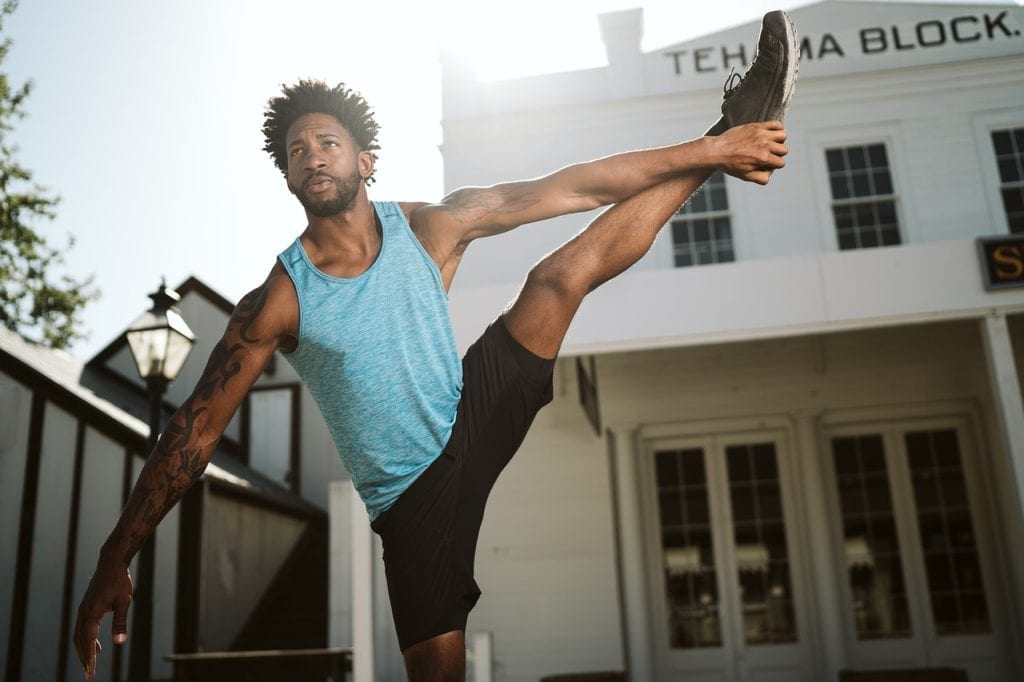
Some runners may not know that post-running stretching is equally important to warm up before you run. Unless you’re healing after sprains or injuries. Then waiting for muscles to heal is important.
It is also a good way of improving blood circulation, lowering the risk of injury and stiffness, and expediting the recovery process.
When stretching after running, it is important that you stretch the right muscles and in the right way to avoid tight muscles and excessive pain after exercising.
To get the most out of your effort, here is a list of the 10 helpful stretches that you can do to help your legs after you run.
10 Different Stretches
Here are 10 stretches you can do to help with recovery after you run. You may not need to do all of these, but for maximum benefit try a new stretch or two that you haven’t done before.
1. Quadricep Stretch
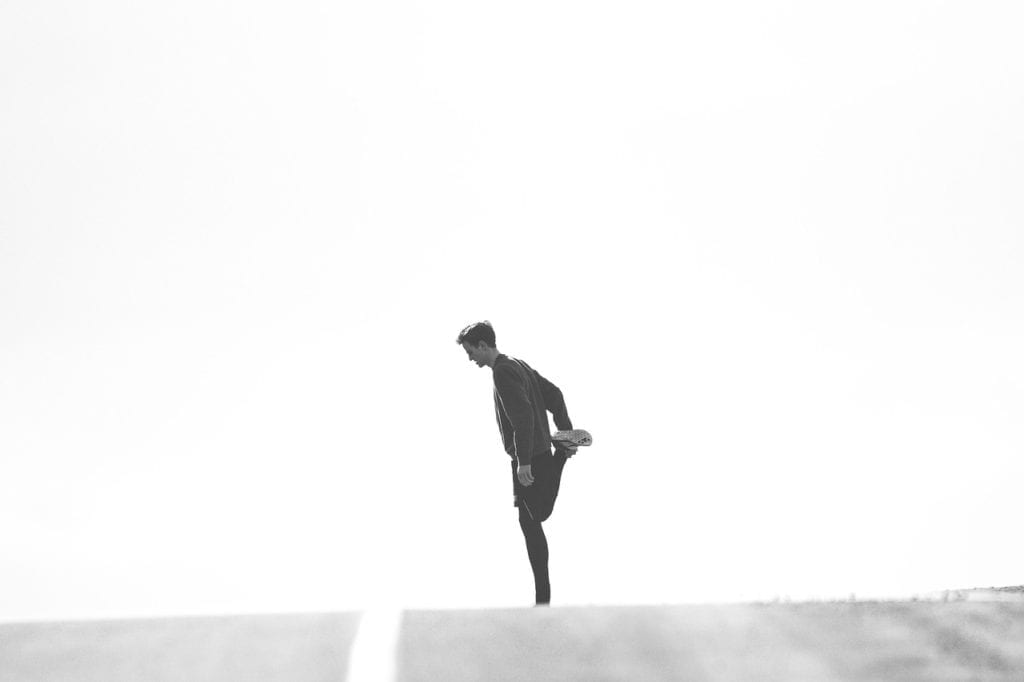
The quadriceps are formed by a set of 4 muscles that are located on the front of your thighbone and that are crucial in walking and running.
One of the muscles (rectus femoris) is attached to the ilium- the uppermost and largest part of the hip bone– and it enables you to swing your leg forward and to flex the hip when you walk or run.
Rectus femoris together with the other three thighbone muscles- the vastus lateralis, vastus medialis, and vastus intermedius- attaches to the kneecap, making them vital in stabilizing the knee joint for a free knee motion whenever you run or do any other leg work. All four also enable you to squat and jump.
Why stretch:
Failure to stretch your quads can make them tight, which can then cause unwanted back and knee pain. In some severe cases, you may suffer from quadriceps tendinopathy whereby the quad muscles become inflamed, causing pain whenever you flex your knee.
How to stretch:
Option 1: Standing quad stretching
- Stand with your knees touching each other and then support yourself on the wall with one hand. For the purposes of this stretch, you can start by holding the wall using your left hand.
- Using your right hand, grab your right foot and pull it towards your backside such that the foot is as close to the butt as possible. While stretching, be sure to push your chest up and hips forward so you can flex the hipbone as well.
- Hold the position until you feel the stretch in your quad muscle- for about 30 seconds- then repeat the two steps above with your other leg.
Option 2: Lying quad stretching
- Lie on your left-hand side and support your head using the left hand.
- Relax in that position for a couple of seconds and then using your right hand, grab your right leg by the ankle and pull the foot as close to your butt as possible. If you feel unstable, you can bend your left knee slightly.
- After about 30 seconds, switch sides and repeat the two steps above with your other leg.
2. Hamstring Stretch
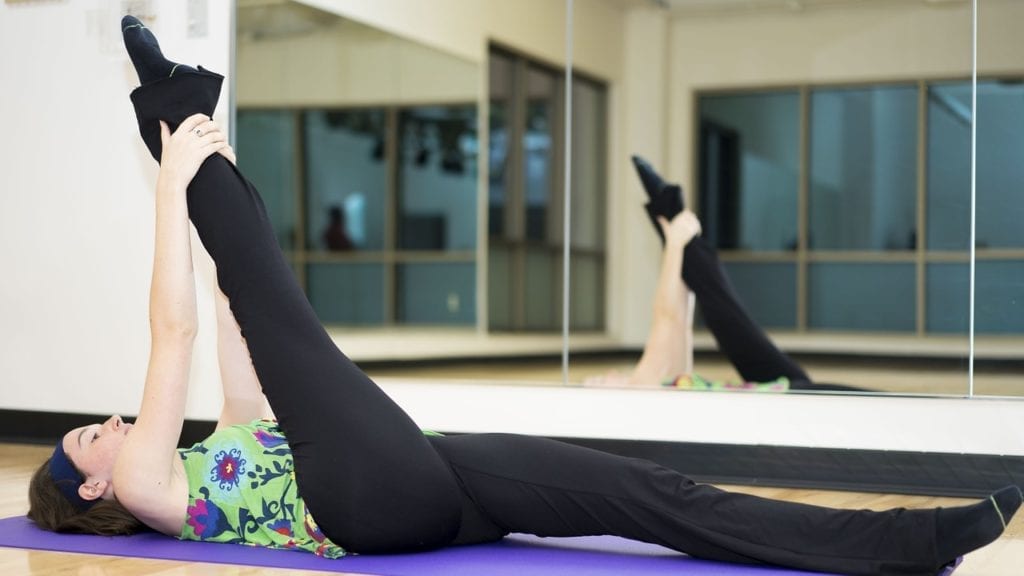
There are three hamstring muscles- the biceps femoris, semimembranosus, and semitendinosus. All of them originate from your pelvis and, through the back of your thigh, connect with the top of the bones of your lower leg. In simple terms, the hamstrings link your hip and your knee joints.
Your hamstrings enable you to rotate your leg in an inward-outward motion, bend your knees when you squat or run and move your hips back and forth. They are also responsible for regulating the speed of your leg when you run, walk, or kick. Whenever necessary, the hamstrings help the gluteal muscles in your butt to push your body forward when you stand from a sitting/squatting position and when you run.
Why stretch:
The hip and the knee joint combine to form the most important weight-bearing unit in your body. If you fail to stretch your hamstrings and they end up getting tight or injured, you may not be able to carry your own weight when running.
Tight hamstrings can force your body to shift much of its weight to the pelvis, lumbar spinal joints, and the upper cervical vertebrae, which leaves almost all the other weight-bearing joints vulnerable to injuries.
How to stretch:
Option 1: Standing hamstring stretch
- Stand upright and ensure that your spine is in a neutral position.
- Place the left leg forward and cross it in front of the right leg. Keep the heel pushed into the ground so that both legs feel stable. Ensure that the right leg isn’t bent, although the left leg will have a slight bend at the knee.
- Ensure the left foot is in front and the right foot is in the back fairly close but stable, and lean forward gently, placing both hands on the left leg. Your back should remain straight.
- Hold the stretch for about 30 seconds before switching to the other leg.
Option 2: Lying hamstring stretch
- On a mat, lie flat on your back with your lower back in contact with the mat, and both legs fully stretched out flat.
- To stretch, bend the left knee as if you were doing a sit-up exercise, and lift the right leg, keeping it fairly straight.
- Hold the back of the lower right leg with both hands and gently pull it up toward your chest. Alternatively, you can use a yoga strap to help keep your leg straight and pull it back gently.
- (Personally, I like to use a strap since it helps me keep my back flat with less stress on it.) (Amazon Link)
- If your right leg is bent as you pull it toward your chest try to straighten it in order to fully stretch the hamstring. Just take it slow and gentle.
- Hold this position for about 30 seconds. You can repeat the procedure with the left leg and try to maintain a flat back as you stretch each leg.
3. Hip Flexor Stretch
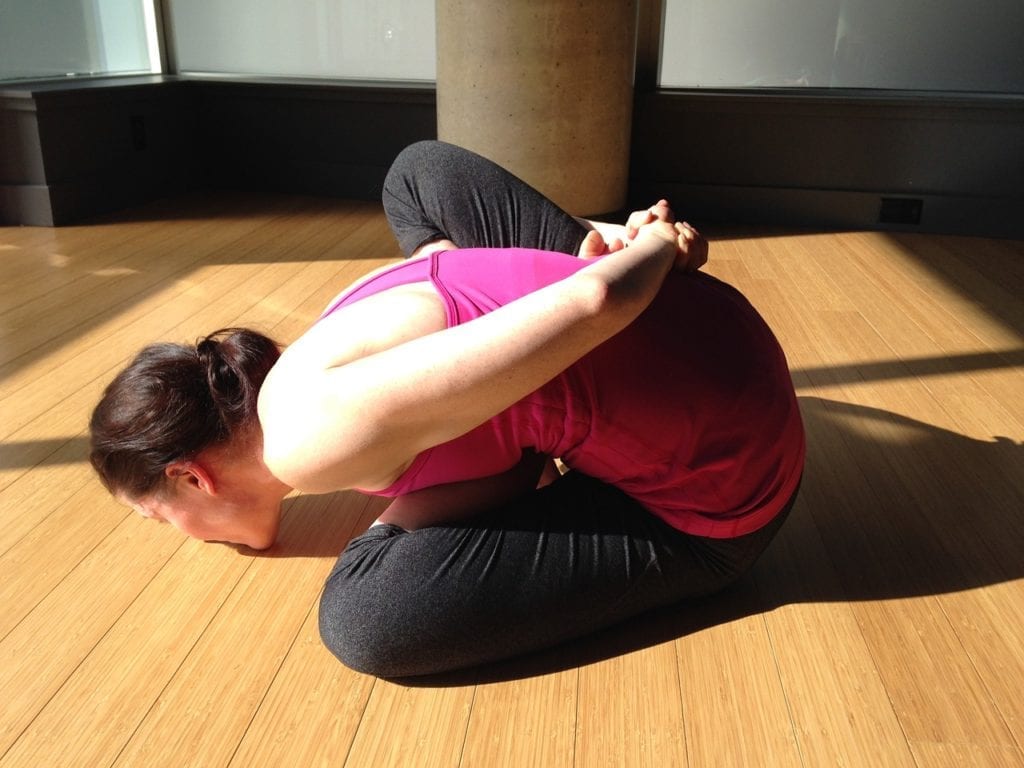
You have 5 main hip flexor muscles: The sartorius muscle, pectineus muscle, iliacus muscle, Rectus femoris muscle, and psoas major muscle. Their primary function is to pull your torso- the part where your limbs are attached- and the bones of the leg, the hip, and the spine together so they can all help bend at the hip. These muscles enable you to move your leg toward your stomach. It helps with kicking, swinging your leg forward, and lift your knee up.
Why stretch:
Your hip flexor muscles can get stiff, tight, or even injured when not stretched properly before and after a straining running session. A torn hip flexor muscle may cause you mild pain but if you have a more severe muscle tear, you can suffer from muscle cramping or spasms as well as hip swelling. These muscles take time to heal after a tear, sometimes taking three months, meaning that you will be limping and cannot participate in any straining physical activity for most of this time.
How to stretch:
Option 1: Piriformis Stretch
- Sit upright on the floor and sit with your legs crossed. This can help start to stretch your muscles.
- If sitting cross-legged feels relaxed and comfortable, then you might be ready for the next step which calls for one leg lying flat on the ground.
- Next, you’ll bend your left knee toward your chest and cross it over your flat leg.
- Then use your right arm to press against your left knee and twist your upper body to your left.
- As you feel the stretch in your muscle hold for about 15-30 seconds and then switch to the right leg.
Option 2: 90/90 Stretch
- Sit upright on the floor with your right knee in contact with the floor straight in front of you. Your right calf should be at a 90-degree angle to your thigh like you are about to sit cross legs.
- Your left leg will straight out to the left with your left knee on the floor and your calf facing behind you. Your right calf and left thigh should be parallel to each other now.
- Keep your right leg and right butt cheek on the floor such that the left butt cheek is a little raised from the floor.
- Support your upper body by placing your hands on the floor in front of your knee, so you can support yourself as you lean toward your left knee.
- While in this position, try to move the left butt cheek as close to the floor as possible.
- Hold for about 30 seconds then reposition your legs, so you can stretch toward the other knee.
4. Calf Stretch

Two calf muscles are – the gastrocnemius and soleus muscles- which merge with the Achilles tendon on the back of your lower leg and then insert into the heel bone.
For any forward movement, the calf muscles are the ones that pull the heels up. They also enable you to place your foot on the ground as you run.
Why stretch:
When running, your calves can stretch beyond their limit and that can lead to partial or complete tearing of the muscle fibers. Calf muscle breakdown is also possible when you subject these muscles to excessive pressure consistently without regular stretching.
How to stretch:
Option 1: The standing calf stretch
- Stand arms-length away from a rigid wall, and then stretch both your hands out to support yourself on the wall while keeping both feet flat on the floor.
- To stretch your right calf, extend your right leg behind you and slightly bend your left knee forward. Ensure that your right knee is straight and that both feet are still flat on the floor.
- With your right leg still straightened and both feet on the ground, lean toward the wall until you feel the tension in its calf muscle.
- Hold for about 30 seconds and then repeat with the other leg.
Option 2: The seated calf stretch
- Sit on the floor and extend both legs straight out in front of you.
- Gently lean forward and, using both hands, reach toward your feet. Place your hands on your legs for support if needed or grab your feet if you are able to.
- Without bending your legs, gently lean towards your feet until you feel a stretch in your calf muscles.
- Hold for about 30 seconds
Alternately, you can stretch one leg at a time by extending both legs in front, in a V shape. Extending your stretch toward one leg before repeating with the other leg.
5. Lower Back Stretches
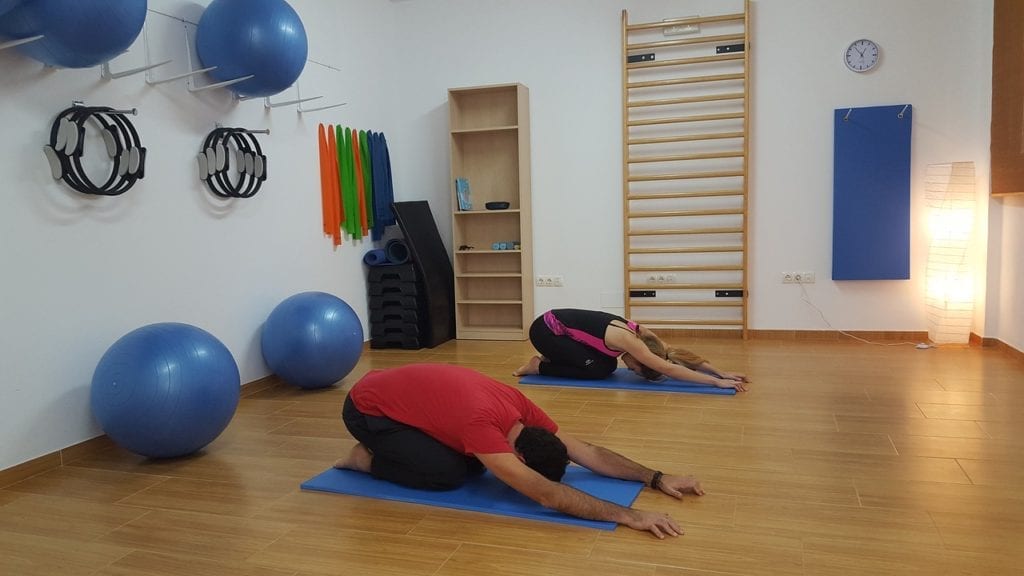
Three lower back muscles- Extensor, Flexor, and Oblique Muscles- support your spine and enable you to twist your trunk. The flexor muscle, in particular, is responsible for flexing your lower back so that you can bend forward as you run.
Why stretch:
Because of the critical role, it plays in forward body movements, your lower back muscles will sometimes feel some tightness or soreness after running.
These conditions will mostly subside on their own but if they are strained or tight for too long, they can morph into pain, spasms, and cramping. In some severe cases, your pelvis, hips, and legs might also be rendered dysfunctional.
How to stretch:
Option 1: Standing lower back stretches
- Stand with your feet apart and your hands on hips, so the elbows are facing out.
- Gently swing your hips from side to side and then after about 10 oscillations, start to rotate your hips in big, one-direction circles.
- After making 10-20 circles, reverse the direction of your circles.
Option 2: Lying lower back stretches
- While lying flat on your back, bend your knees so that you are in a sit-up position. Ensure that both your knees as well as inner thighs are as close as possible.
- Place your arms straight out from your body on the ground for stability.
- Without separating your knees, moving your head, or lifting your shoulders, drop the knees down to the left as you exhale slowly.
- When you can’t lower them any further hold that position for 10 – 30 seconds, and then drop your knees to the right and hold the same amount of time.
- Inhale and lift your knees up into your original neutral position. You can rest in this position momentarily and then continue dropping your knees down again if needed.
6. Groin Stretch
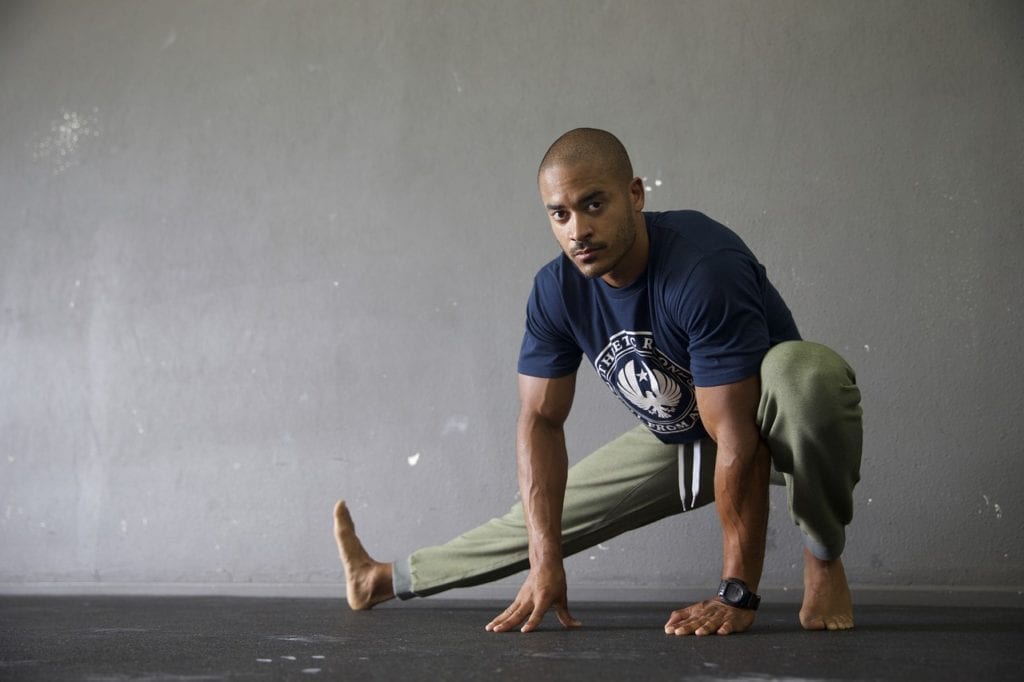
Your groin area has five adductor muscles that are located on the innermost part of your thigh. They include magnus, pectineus, brevis, longus, and gracilis adductor muscles.
The primary responsibility for these muscles is the movement of the upper thigh for optimal athletic mobility. While running, in particular, these muscles enable you to move your thighs in different directions.
Why stretch:
Because the groin muscles are very close to the center of your body, they are involved in almost all upper and lower body movements. Also, these muscles are vital in your high-speed activities such as kicking and sprinting. That makes them vulnerable to straining, muscle spasm, and tightness. These injuries are mostly mild but when left unattended for long, you may require surgical intervention.
How to stretch:
Option 1: Standing groin stretches
- Stand with your legs 2-3 feet apart.
- Holding your left thigh and as you bending your left knee outward to a semi-crutching position, shift your weight to the left with the right leg straightened.
- As you bend the knee, you will start to feel the stretch in your right groin. Keep going until the knee is perpendicularly above your left foot.
- Keep your left foot on the ground facing out for about 30 seconds as you stretch and then relax.
- Repeat the stretch on the right side in the same manner.
Option 2: Seated groin stretches
- Sit upright on the ground and bend your knees as you open your legs such that the soles of your shoes come together. Pull your feet closer to your groin.
- Hold ankles or legs with both hands and rest your elbows near your knees. Ensure that you are your back is relatively straight if possible.
- Use your elbows to apply gentle pressure on your inner thigh so that the knees start moving towards the ground, and until you start feeling a gentle tension in the groin.
- It may be difficult to keep your back straight, but try to keep it straight and lean forward. This will also stretch your muscles, so you may not need to apply pressure on your legs.
- Be careful not to overdo it, since it may feel like you can lean far forward. Just remember to keep the back straight and achieve a gentle stretch.
- Hold the stretch for about 30 seconds and then release.
7. Glute Stretch
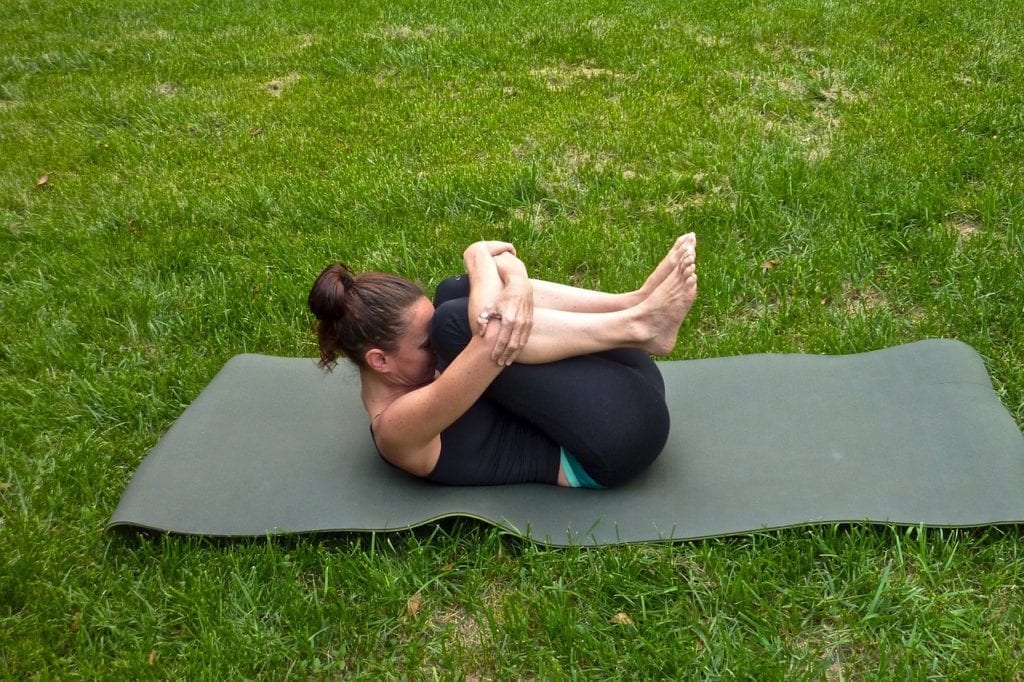
Your buttocks have three important muscles: The gluteus maximus, gluteus medius, and the gluteus minimus. They all run from the top of your thighbone up to the hipbone. These muscles are crucial for any runner because they aid in the legs’ forward extension and the thigh’s outward rotation. They also pull away from the thighs from the hip area to facilitate your climbing of stairs, rising from a sitting position, and running.
Why stretch:
Butt muscles are connected to the pelvis, hip, thigh, and lower back muscles. When you exercise for long without stretching them, all those connected muscles can become tight, sore, painful, and unstable.
How to stretch them:
Option 1: While sitting on the ground
- Sit on the ground in criss-cross position, left leg over the right. Then lift your left knee up toward your chest and reposition your foot so it is pulled out to the right with the ankle flat on the ground and toes pointing out.
- Pull your right leg out so it lies flat on the ground and is somewhat under your left knee.
- Hold that position for about 30 seconds and then switch legs.
Option 2: While lying down
- Lie flat on your back and bend both knees in the air such that they are right above the glute muscles.
- Cross your right leg over the left leg so that your right ankle is resting on the left knee.
- If you pull your uncrossed left leg toward your chest in this position, you are going to feel a stretch in your right buttock. Do that and hold for 20 to 30 seconds before switching legs.
8. Tricep Stretch
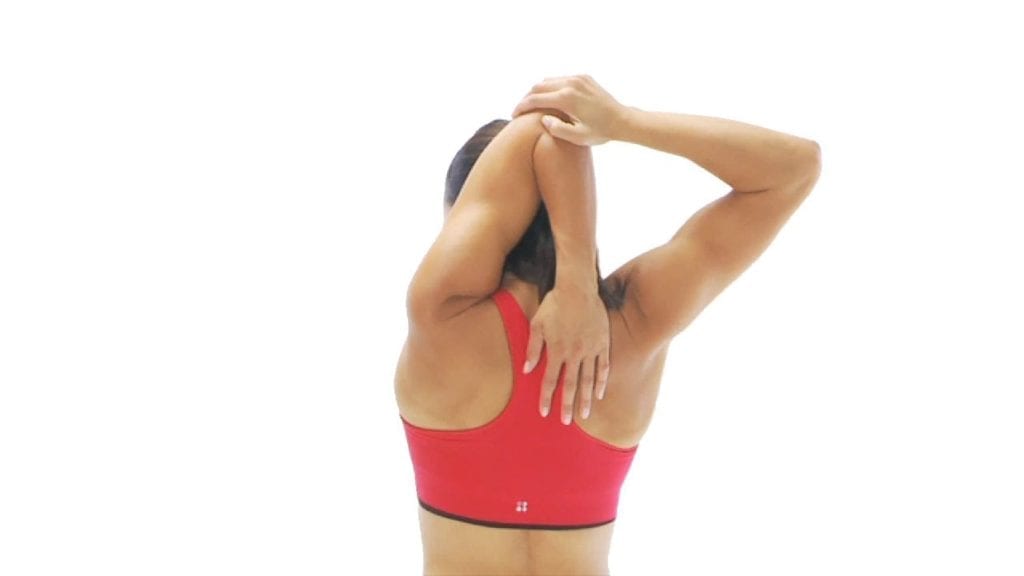 Credit: https://www.youtube.com/watch?v=zzvDO56B0HE
Credit: https://www.youtube.com/watch?v=zzvDO56B0HE
The triceps muscle has three heads- long, medial, and lateral, all of which originate at the socket of the scapula and runs into the elbow joint. They are located deep in the back of your upper arm, making them critical in the extension of your forearm around the elbow joint.
Why stretch:
On top of helping you to lift and extend your forearms as you run, the biceps also enhance your shoulders’ mobility. And because no muscle operates in isolation, stretching your triceps after a run will also benefit your lower back, butt, and hip muscles.
How to do it:
Option 1: Standing triceps stretches
- Stand with your feet 1-2 feet apart and extend your right arm over your head.
- Bend your right elbow and bring your right palm down your back as if you want to scratch the right side of your upper back. Take it as down as you can.
- Using your left hand, gently pull the right elbow to the left until you feel a stretch. Hold that position for about 30 seconds then switch arms and repeat.
Option 2: Seated
- Sit upright on the floor and cross your legs.
- Fold a towel lengthwise or find a long piece of cloth. Place it on your right shoulder such that the longer part hangs down your back.
- Keeping your chest lifted, hold the towel in your right hand and then move your right elbow upwards so that the towel lowers even further down your back.
- Grab the back end of the towel in your left hand and pull it gently down until you feel some tension developing in your right tricep.
- Hold for 30 seconds and then repeat on your left tricep muscle.
9. Iliotibial Band (IT Band) Stretch
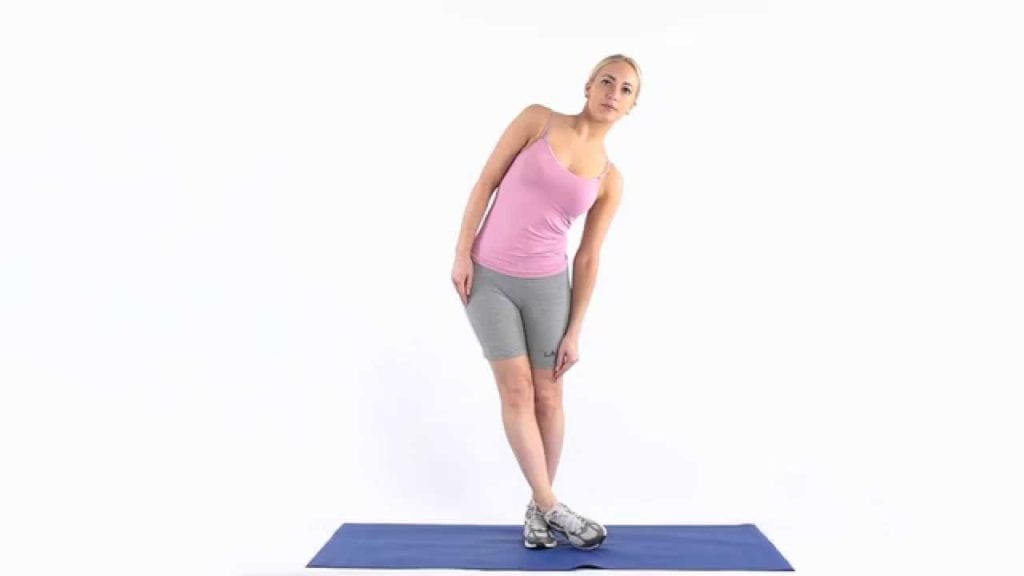 Credit: https://www.youtube.com/watch?v=GodaVDAhOYQ
Credit: https://www.youtube.com/watch?v=GodaVDAhOYQ
ITB is a regular, connective fibrous tissue that envelops the sideward muscles in your thigh. It connects the shinbone- a frontal bone in your lower leg- and the hip muscles. It also assists your buttock muscles in extending your knees when you run or walk.
Why stretch:
When your knee flexes, the iliotibial band moves posteriorly over the bones of your lower limb, to and fro. The oscillatory flexion and extension get intense when you take part in long-distance running and can result in inflammation, irritation, and pain. Stretching minimizes these effects.
How to stretch:
- While standing tall, cross your right leg behind your left leg.
- Ensure that both feet are on the ground, and then lean to your left side such that your right hip shifts outwards. Avoid leaning forward or sticking your buttocks out for optimal results.
- You will feel the tension building in the lateral part of your right thigh. Hold that position for about 30 seconds before repeating with the left leg.
10. Ab Stretch
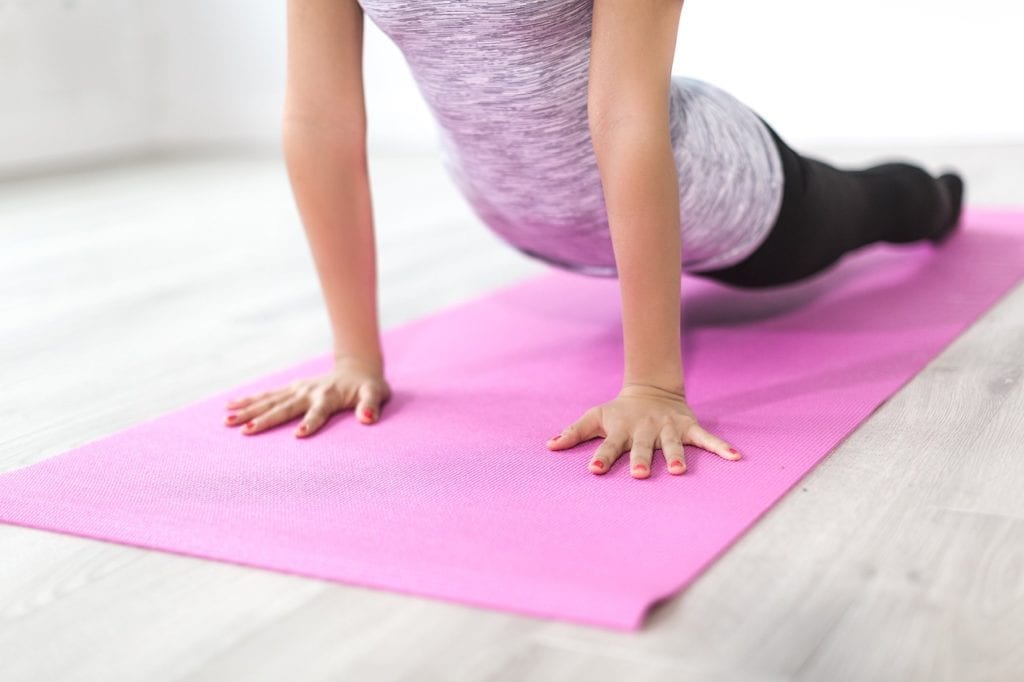
This is arguably the most common post-running stretch out there. The abs (abdominal muscles) consist of the internal and external obliques, erector spinae, and the famous six-pack (rectus abdominis).
Why stretch:
Strong abs make your core strong and stable, keeping you from deflecting the energy you build as you run and, consequently, you can run faster. Stretching your abs also benefits your lower arms, biceps, pelvis, lower back, and hips.
How to stretch:
• Option 1: Standing
- Stand with your feet apart.
- Hold your right wrist in your left palm and fully stretch both arms above your head.
- Step back with your left leg if necessary and shift your weight to the left and lean back as far as you can. Stop when you feel some tension in your abs or pain in your lower back. Straighten up again and repeat with the right arm.
• Option 2: Lying down
- Lye on the floor and bring yourself up to a push-up position with arms fully extended.
- Lower your hips toward the ground while keeping your legs and arms straight.
- Hold the stretch and then slowly lower yourself to the ground to rest.
Conclusion
Stretching exercises after a run are particularly beneficial because all the muscles in your body are warm and elastic.
When stretching, however, always stop when you feel slight pain or discomfort; don’t overdo it to the point of hurting other muscles.
And as we said earlier, no muscle works in isolation: Stretching one of them makes a handful of other muscles flexible and healthy.
Thanks for visiting Helpshoe.com

